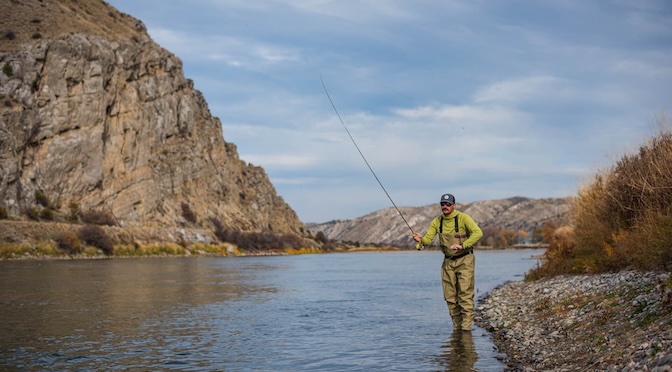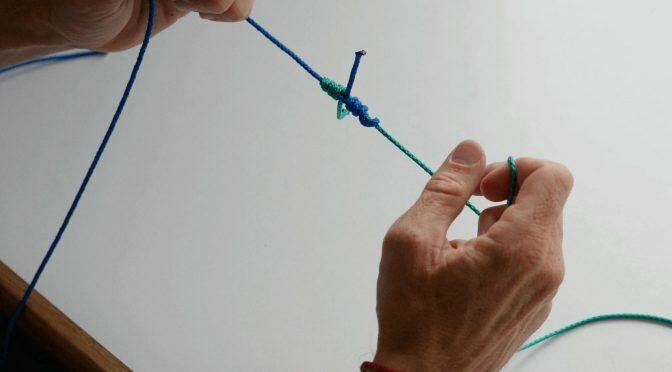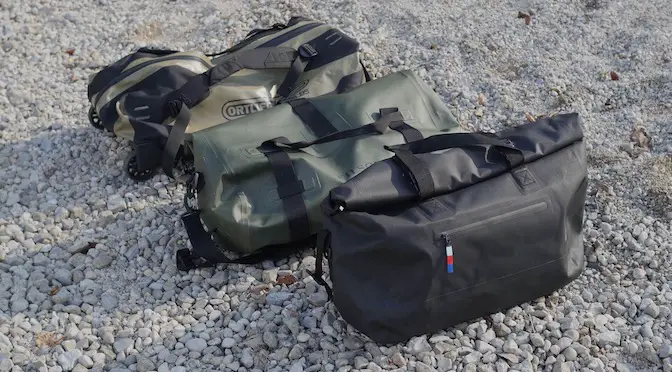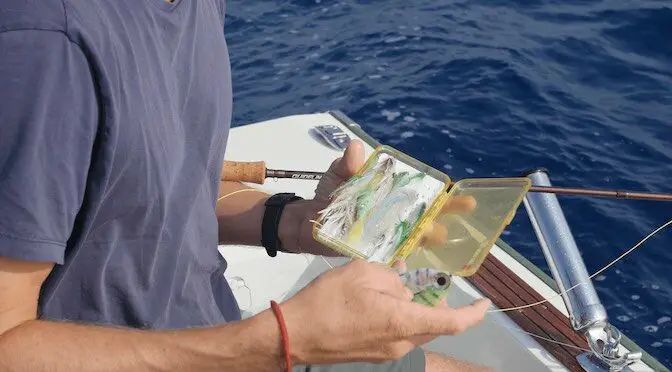Last updated on November 10th, 2025.
- Can YETI’s new backpack deliver? Thoughts on the YETI CAYO - November 20, 2025
- How to Put a Worm on a Hook: Proven Methods for a Perfect Bait - November 18, 2025
- How to Fish in a River: An Essential Guide to Proven Techniques - November 18, 2025
The On-the-Water Comfort Code
Achieving on-the-water comfort comes down to three core principles: mastering layering, choosing performance fabrics over cotton, and dressing for both stealth and sun protection. These rules form the foundation of a system that will keep you safe, comfortable, and focused on the fish, regardless of the weather.
Master the Art of Layering. Your ability to add or remove clothing layers is the single most important factor for regulating your temperature and staying comfortable from a cold morning to a warm afternoon. This simple strategy allows you to adapt in real-time to changing conditions, ensuring you’re never too hot or too cold.
Choose Performance Fabrics, Not Cotton. Avoid cotton at all costs. It absorbs water, loses all insulating properties when wet, and can lead to dangerous hypothermia. Prioritize synthetic, quick-drying, and moisture-wicking materials like polyester, nylon, and fleece, or natural performance fibers like merino wool.
Dress for Stealth and Sun Protection. Fish are easily spooked. Wear drab, earth-tone colors like olive, tan, and gray to blend in with your surroundings. At the same time, protect yourself from the sun with long sleeves, hats, and sunglasses. A complete on-stream system involves more than just clothing; it’s also crucial to understand your tackle, starting with what type of fishing line to use for your target species and conditions.
Why Your Clothing Is Your Most Important Piece of Gear
Your clothing is critical gear because it directly impacts your safety by preventing hypothermia, your success by providing stealth from fish, and your performance by allowing a full range of motion. Thinking of your apparel as a technical system is the first step toward becoming a more effective angler.
The Safety Imperative: Avoiding Hypothermia. Wearing the wrong materials, especially cotton, is not just uncomfortable—it’s a safety risk. Wet cotton pulls heat from the body 25 times faster than dry air, drastically increasing the risk of hypothermia even on cool, 60-degree days. Performance fabrics that wick moisture and dry quickly are essential for safety.
The Stealth Advantage: Don’t Spook the Fish. Bright colors are a major liability, especially in clear or slow-moving water where fish are wary. Earth-tones help you blend into the streamside environment of rock, trees, and foliage, allowing you to get closer to your target without being detected.
The Performance Factor: Freedom of Movement. Your clothing must allow for a full range of motion for casting, mending line, and navigating tricky terrain. Focus on lightweight, stretchable materials that don’t bind or restrict your movement. Dressing correctly means you’ll stay out longer and increase your chances of a successful catch, and when that happens, you’ll want to have the best electric fillet knife ready back at home.
The 3-Layer System: Your Personal Climate Control
The 3-layer system provides personal climate control by using a base layer to wick moisture, a mid-layer to insulate, and an outer shell to protect you from wind and rain. Understanding how these layers work together allows you to build a versatile wardrobe for any season.
LAYER 1: The Base Layer. This is your next-to-skin layer. Its only job is to wick moisture (sweat) away from your body to keep you dry. A dry body is a warm body. Use synthetic materials like polyester or natural fibers like merino wool for your base layer.
LAYER 2: The Mid-Layer. This is your insulation layer. Its job is to trap your body heat, creating a pocket of warm air. Fleece jackets, vests, or lightweight puffy jackets are perfect examples. This layer should be non-bulky to fit comfortably under your shell and should be easy to take off and stow in a pack if you get too warm.
LAYER 3: The Outer Shell. This is your weather protection. A waterproof and breathable rain jacket is essential to block wind and rain, keeping your insulating layers dry and effective. Without a good outer shell, your mid-layer will get wet and lose its ability to keep you warm.
Your Action Plan: The G.E.A.R. System for All-Season Angling
The G.E.A.R. system provides a simple head-to-toe framework for outfitting yourself: (G)uard your head and eyes, (E)ngineer your core comfort, (A)dapt your lower body, and (R)ig your extremities and essentials. This checklist ensures you never forget a critical piece of apparel.
STEP 1: (G)uard Your Head & Eyes.
- Hats: A hat is critical for sun protection, warmth, and reducing water glare. A wide-brimmed booney or bucket hat offers 360-degree coverage, while a long-brimmed baseball cap excels at blocking glare. For winter, a warm beanie or a fleece-lined hat with ear flaps is essential. A chin strap is a valuable feature to prevent your hat from blowing away in the wind.
- Sunglasses: Polarized sunglasses are non-negotiable. They provide essential eye safety from errant hooks and dramatically reduce surface glare, allowing you to see fish and underwater structure. Match your lens color to the conditions: green mirror lenses are excellent for clear water, while copper-colored lenses are a great all-around choice for muddy or variable conditions.
- Neck Gaiters: A versatile neck gaiter (or Buff) provides sun, insect, and wind protection for your neck, face, and ears. On cool days it adds warmth, and on hot days you can dip it in the water for a personal cooling effect.
STEP 2: (E)ngineer Your Core Comfort.
- Shirts: The ideal fishing shirt is long-sleeved, made from a synthetic material like polyester, and is both quick-drying and moisture-wicking. Look for shirts with a built-in UPF rating of UV 40+ or higher for maximum sun protection. Features like a flip-up collar for extra neck coverage and roll-up sleeve tabs add valuable versatility. A lightweight, hooded sun shirt offers the most complete coverage.
- Mid-Layers: This is your primary insulation. A fleece jacket or a lightweight, packable puffy jacket traps body heat effectively. It should be non-bulky to allow for easy casting and comfortable layering under your rain jacket.
- Outer Shells: Your rain jacket is your shield against wind and rain. It must be both waterproof and breathable to prevent you from getting soaked by rain from the outside or sweat from the inside. Ensure the hemline falls below your hips so it doesn’t ride up while you’re casting or reaching.
STEP 3: (A)dapt Your Lower Body.
- Pants & Base Layers: Lightweight, durable, and quick-drying nylon pants are the standard for fly fishing. They offer protection from the sun, insects, and streamside brush. Convertible pants with zip-off legs offer great versatility for changing temperatures. In cold weather, wear a moisture-wicking base layer of long johns underneath your pants.
- Waders: If you plan to stand in the water, you need waders. Breathable chest waders are the most versatile for fishing in various depths. Waist-high waders are a cooler option for summer, while hip waders suffice for very shallow streams. For winter, insulated boot-foot waders keep your feet warm, but for most conditions, stocking-foot waders paired with separate wading boots offer better support and fit. Always wear a wading belt for safety.
- Footwear: Wading boots provide crucial ankle support and traction on slippery, uneven riverbeds. Soles come in felt or rubber, and studs can be added for extra grip. For summer “wet wading” without waders, pair your boots with neoprene guard socks. For winter, wear a single pair of medium-weight wool socks; avoid wearing too many pairs, as this can restrict circulation and make your feet colder.
STEP 4: (R)ig Your Extremities & Essentials.
- Gloves: In cold weather, gloves are essential for warmth and hand protection. Fingerless wool gloves are a classic choice because they provide warmth even when wet and allow for the dexterity needed to tie knots. Fold-over mittens are another excellent option.
- Packs & Vests: A fishing vest or sling pack is used to organize your tools, fly boxes, and accessories. Your vest or pack is where you’ll organize your tools and terminal tackle, so you always know where to find essentials like forceps or understand what is a tippet when you need to change your leader setup.
- Other Essentials: Always carry a few other key items. A wading staff provides a third point of contact for stability when crossing streams. In winter, chemical hand warmers and a small hand towel can be a lifesaver. Finally, never leave home without waterproof sunscreen of at least SPF 30 and a reliable insect repellent.
3 Common Wardrobe Mistakes That Ruin a Day on the Water
Three common wardrobe mistakes that can ruin a fishing trip are over-stuffing your boots, which makes feet colder; forgetting a packable rain jacket; and underestimating sun exposure on the water. Avoiding these simple errors will dramatically improve your comfort and endurance.
MISTAKE 1: Over-Stuffing Your Boots. It seems counterintuitive, but wearing too many pairs of socks will make your feet colder, not warmer. The extra bulk restricts blood circulation, which is what your feet rely on to stay warm. Stick to a single pair of quality, medium-weight wool or synthetic socks.
MISTAKE 2: Forgetting the “Just-in-Case” Jacket. Weather in the mountains or on the water can change in an instant. A lightweight, packable rain jacket should always be in your pack, even if the forecast is clear and sunny. It serves as your primary defense against unexpected rain and is an excellent windbreaker when the breeze picks up.
MISTAKE 3: Underestimating Sun Exposure. Novice anglers often focus on staying warm and dry, completely forgetting about the sun. The sun’s rays reflecting off the water’s surface can double your UV exposure, leading to a nasty burn. A complete sun-protection system—a wide-brimmed hat, polarized sunglasses, and a UPF-rated long-sleeve shirt—is not optional.
From Anxious Novice to All-Weather Angler
Following this guide transforms you from an anxious novice into an all-weather angler, giving you the confidence to face any condition, the endurance to stay on the water longer, and a deeper focus on fishing.
Confidence in Any Condition. You will no longer have to check the weather with anxiety. With a proper layering system and the right gear packed and ready, you’ll be equipped to handle heat, cold, wind, and rain with confidence, knowing you have the right tool for the job.
More Quality Time on the Water. Comfort is endurance. By eliminating the physical distractions of being too hot, too cold, or soaked through, you can stay on the water longer. This means more casts, more opportunities, and more enjoyment from every moment of your time fishing.
A Deeper Focus on Fishing. When your clothing system works perfectly, it becomes invisible. You can stop thinking about your gear and focus completely on the real challenges: reading the water, perfecting your cast, choosing the right fly, and connecting with the fish.
Frequently Asked Questions
What are the three core principles for dressing for fly fishing?
The three core principles are mastering a layering system for temperature control, choosing quick-drying performance fabrics over cotton, and dressing for both stealth with earth-tone colors and sun protection with hats and long sleeves.
What should you wear when you go fly fishing?
A complete fly fishing outfit includes a moisture-wicking base layer, an insulating mid-layer like fleece, and a waterproof outer shell. Add quick-drying pants, a wide-brimmed hat, polarized sunglasses, and wading boots with waders for fishing in the water.
What colors should you wear fly fishing?
You should wear drab, earth-tone colors like olive, tan, and gray to blend in with the natural surroundings. Bright colors can easily spook fish, especially in clear or slow-moving water, reducing your chances of a successful catch.
What shoes do you wear for fly fishing?
If you plan to stand in the water, you must wear wading boots, which provide essential ankle support and traction on slippery riverbeds. For fishing from a boat, wear shoes with non-marking, no-slip soles to ensure stability and protect the boat’s deck.
What should you absolutely not wear when fly fishing?
Avoid wearing cotton clothing, like jeans and t-shirts, at all costs. When cotton gets wet, it loses all insulating properties and can lead to dangerous hypothermia by pulling heat away from your body, even on a cool summer day.
What are polarchromic sunglasses lenses?
Polarchromic lenses are advanced polarized lenses that are also photochromic, meaning they automatically adjust their tint based on UV light exposure. This makes them highly versatile, as they adapt to changing conditions from bright sun to overcast skies.
What are the best features to look for in a fishing hat?
Look for a hat with a wide brim for maximum sun protection, a chin strap to prevent it from blowing away, and UPF-rated fabric. For rainy conditions, a waterproof material is ideal, and some caps feature a neck cape for extra coverage of the neck and ears.
Besides clothing, what other essential items should you bring fly fishing?
Always carry your fishing license, a basic first-aid kit, waterproof sunscreen of at least SPF 30, and insect repellent. A wading staff for stability and chemical hand warmers for cold days are also highly recommended for safety and comfort.






